With the holiday season just around the corner, we take a closer look at how to prepare for these crucial months in our latest article.
The holiday season is important every year, but this year, it somehow feels even more crucial.
For starters, you have to make up for the dip during the lockdown months. Your customers, too, need the stability of family and holidays to counter the uncertainty of the pandemic.
There’s just one problem: the pandemic has disrupted most marketing playbooks completely.
In-store promotions, tried-and-tested ad creatives, proven products - everything has changed. You have to go back to the drawing board and chart a marketing strategy that works specifically for the current times.
With November just around the corner, you don’t have a lot of time either.
Below, I’ll take a closer look at the major changes in customer behavior this holiday season. I’ll also share a list of to-dos to accomplish to end the year on a high note.
3 Trends to Watch Out For
There are three key shifts in shopping behavior that are driving the 2020 holiday season. Let’s look at these in more detail below:
1. Customers are looking forward to the holiday season
After weeks of lockdowns and months of social distancing, you’d think that weary customers might be happy with a muted holiday season.
That doesn’t seem to be true.
Data from Pinterest suggests that customers are anticipating the holidays more than before. Volume for holiday-focused search queries spiked more than 77% this year.

As the company’s CMO, Andréa Mallard says:
“There may never be another holiday season quite like this one. Pinners started searching for holiday ideas in April.”
It’s easy to understand this anticipation. Lockdowns, social distancing, and work from home mean that many people didn’t get to spend as much time with friends and family as they’re used to.
The pandemic has also made people more grateful - 7 out of 10 respondents in Pinterest’s survey said that they want to celebrate the small moments as much as the big ones.
You can see this early start to the holiday season in Amazon’s Prime Day dates. Amazon hosted its flagship sale on October 13, 14 this year to tap into pent-up demand - even at the risk of undercutting its traditional Black Friday/Cyber Monday promotions.
A National Retailers Federation (NRF) survey also had similar conclusions - 74% of respondents said that they expect the holiday shopping season to stretch over several months.
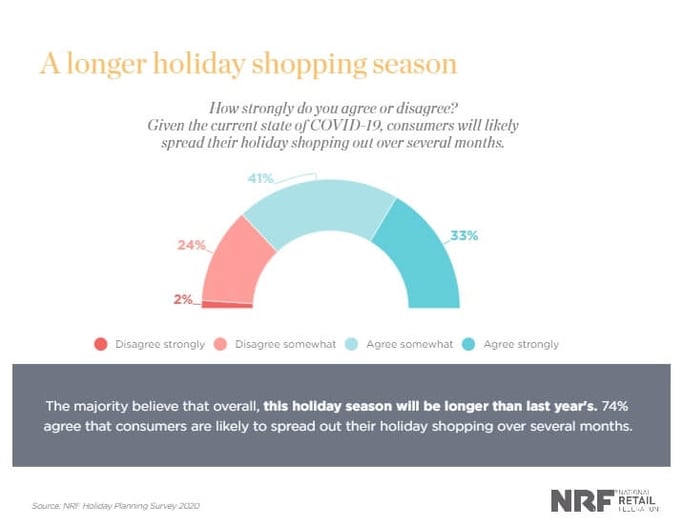
2. Shopping behaviors are changing
If there’s one thing we can say for certain in 2020, it’s that shopping behavior has changed drastically across demographics. Customers who never even thought of online shopping are making their first purchases online. Those who were already used to online shopping are now going almost entirely online.
Salesforce’s twice a month research surveys offer a wealth of data. According to the publicly available data, 81% of consumers said that they’re shopping online more than usual. Surprisingly, this figure holds up even for Baby Boomers!
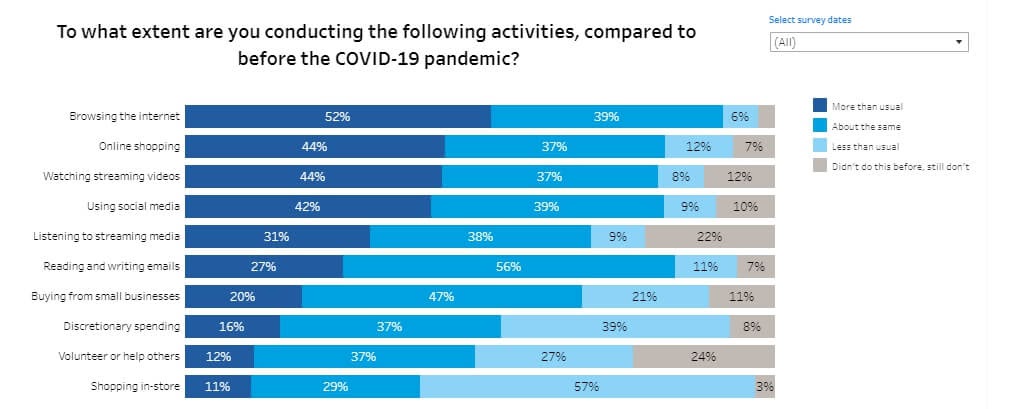
In contrast, 66% of Baby Boomers said that they’re shopping less than usual in stores.
These numbers are true across the world with most respondents in a BazaarVoice survey saying that they’re shopping more online than before.
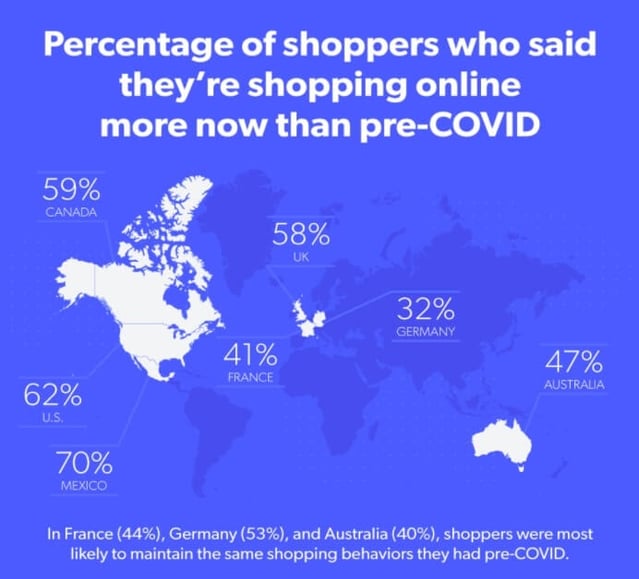
Within online shopping, the skew towards mobile commerce is clear as well. eMarketer estimates 2020 m-commerce sales to touch $71.3B - a 19% increase over last year.
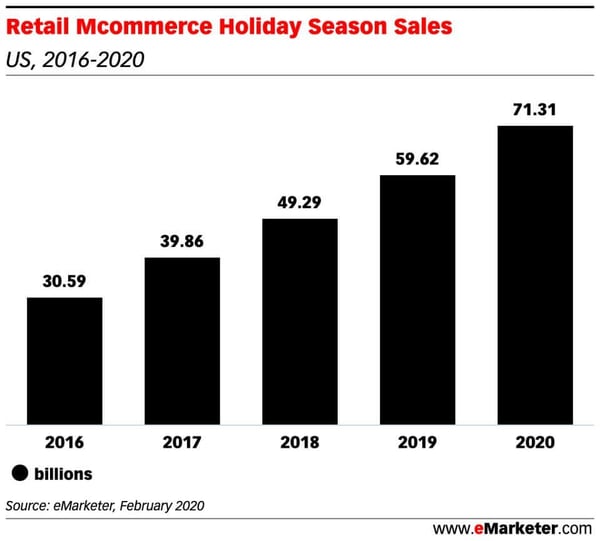
Another survey by payments company Sezzle concluded 82% of respondents are more likely to use their smartphones to shop over Thanksgiving.

But just because people are shopping online doesn’t mean that they’re ready to pay or wait for shipping. Buy online, pick up in-store (BOPUS - also called ‘click-and-collect’) is expected to increase this year as shoppers look to get both the convenience of online shopping and the speed of in-store pickup.
.
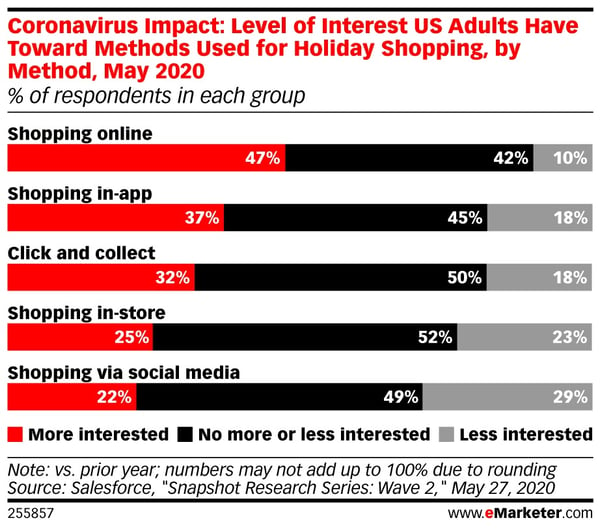
From this data, four changes are clear:
- Customers are less likely to shop in-store than before
- Online shopping will grow, even for older demographics
- Mobile commerce will form an even larger chunk of online shopping
- Customers will look to cut shipping costs and time by buying online, picking up in-store
3. Discounts and value deals are more important than ever
The pandemic has hit economies worldwide. While every shopper looks for discounts in the holiday season, this time around, they’re going to want even bigger and better deals.
A majority of respondents in a BazaarVoice survey said that COVID has impacted their holiday spending. Another survey found that 1 in 4 Americans are cutting their spending because of the pandemic.
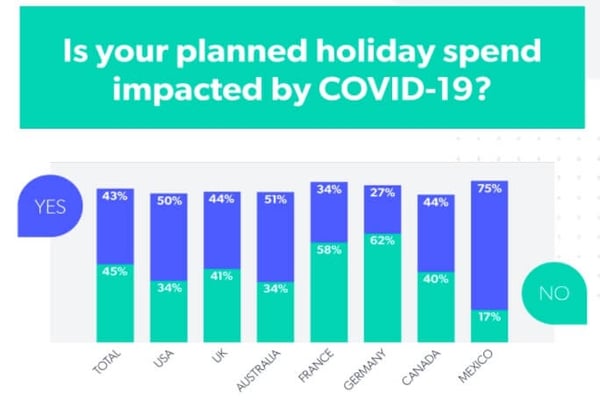
Apart from smaller budgets, customers are also wary of the kind of gifts they buy. Shoppers are less likely to gift anything that requires physical contact - physical gifts, experiences, and services.

You might gift someone spa coupons or tickets to Coachella in a “normal” year, but this year, you’ll likely choose something safer and less social. Massive product categories - such as travel - are expected to find limited takers in 2020.
Given smaller budgets, customers will prioritize discounts and big deals. In fact, a MorningConsult study found that “great value” will be the single biggest driver of buying decisions in the 2020 holiday season:

To conclude, make sure that whatever you market:
- Is ‘COVID-safe’ and doesn’t put the customer at unnecessary risk
- Offers great value and immediate utility
With these trends in mind, I’ll share a list of to-dos you need to wrap up to be 100% ready for the 2020 holiday season.
Five Key 2020 Holiday Season To-Dos
Before the holiday season officially starts, make sure that you’re ready for prime-time by taking these steps:
1. Review your brand message
In a time of uncertainty, any brand message that might be construed as divisive is a liability. People are looking for comfort and safety more than ever.
While holiday brand messaging is almost always positive and family-focused, now is the time to push the message of “togetherness” even more.
This should reflect in both your ad creatives (which we’ll discuss below) as well as your overall messaging. Position yourself as a responsible, comfortable, and perhaps most importantly, reliable brand.
Some ways to do this include:
- Emphasizing your history: A brand that has been around for years implies a certain solidity and certainty - much needed quantities during a pandemic.
- Focus on safety: Point out how you’re keeping your customers and employees safe In these tough times, pushing safety is the least risky position to adopt.
- Focus on giving: The holiday season is all about giving. At a time when millions are struggling, it doesn’t hurt to emphasize how you’re helping your community and the less fortunate.
- Talk about your employees: Did you stand behind your employees and help them tide through the pandemic? Customers want to hear this side of the story. Tell them about the measures you took to safeguard the health of your employees.
While good products and reputation are still paramount, customers are increasingly willing to reward brands that treat their employees well and respect customer privacy.
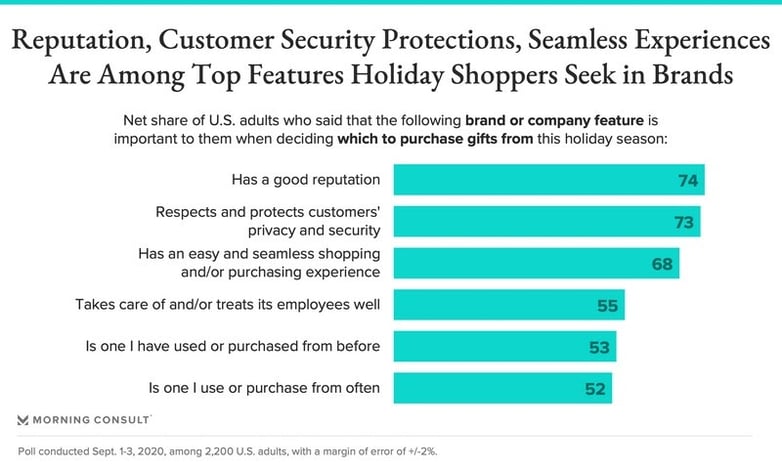
Keep this in mind when you review your brand message.
2. Review your marketing collateral
Funny, quirky, action-packed - all of these would have been great qualities for a holiday ad campaign before 2020.
But this year, you have to be a little more circumspect.
Lots of people have been affected by the pandemic. Some have lost their jobs. Some their loved ones. An ad that’s too quirky or on the nose is liable to offend some people. It also goes against the zeitgeist.
Smaller shopping budgets this year also mean that customers are more careful about their purchases. They don’t want to buy the first thing that catches their eye; they want proven products with clear benefits.
MorningConsult’s research bears this out - ads that focus on benefits are more likely to drive purchases than purely entertaining ads.

Make sure that your campaigns this year really hammer in the benefits you bring to the table. Don’t just count on a feel-good but empty message. Tell people exactly why you deserve their hard-earned cash.
And while you’re at it, review all your creatives to ensure that they emphasize all the right things: togetherness, family, friends, unity, and happiness.
3. Invest in recreating the store shopping experience
Customers are still wary of visiting stores. All the browsing and window shopping that they would normally do in stores or at the mall is shifting online.
While most retailers already have online stores, most of these don’t come close to offering a physical store-like browsing experience.
Before the holiday season starts, try to:
- Make browsing as easy and seamless as possible
- Enhance listings with additional visual content
- Create interactive experiences
Essentially, your goal should be to transport shoppers to your “physical” store, but online. Help them browse and search and find products as they would in a real store.
Here are some ways to accomplish this:
- Create personalized shopping experiences: Ask customers for their requirements and personalize the store as per their needs.
- Offer shopping assistance: Use human or AI-powered online shopping assistants to help customers find what they want. Think of these as the online versions of in-store assistants.
- Create better visual content: Aside from high-quality images, add videos, 3D images, etc. to product listings. These are instrumental in creating a better browsing experience.
- Enhance listings content: In a value-driven holiday season, shoppers need more information before making purchase decisions. Make sure that, at a minimum, your listings have product features, key benefits, and tech specs.
- Improve store performance: Do the images load quickly? Is the store easy to navigate? Is the website fast enough? Make sure that there are no technical shortcomings in your online store.
We make Workamajig, the all-in-one project management suite built for creative teams
- Everything in one place
- Project Management
- Resourcing & Scheduling
- Custom Dashboards
- Business Insights
- Task Management & Time Tracking
4. Adjust your marketing mix
Since shopping is moving online, your marketing has to follow suit. If traditional advertising is still big in your marketing mix, this is the right time to reconsider.
Social has to be a big part of your marketing mix now, especially if you sell to younger audiences. Salesforce estimates that for all retailers, more than 10% of orders will come in directly through social media, with a higher percentage for smaller brands serving younger demographics.
More than orders, however, social continues to be a key channel for discovery and inspiration.
Before the holiday season starts, make sure that your social channels tick the following boxes:
- Are aligned with your overall brand message
- Follow the same visual theme as the rest of your brand
- Use a style and format that’s relevant to your social media audience
The most important part of using social media right now is balancing the message between empathy and advertising. You want to come across as helpful and honest. But you have to balance that with a very real need to drive customer action with your posts and tweets.
You’ll also have to be careful about unnecessarily stepping into controversies. A single poorly-worded tweet can end up in a PR disaster. Unless you know what you’re doing, it’s best to avoid any controversy altogether.
Lastly, keep in mind ad inventories are all over the place right now. Some advertisers have pulled back from once hotly-contested ad slots (such as travel), while there is intense competition in other slots (such as health).
If you haven’t done it already, now is a good time to invest in programmatic advertising. It can help you find the best available slots for your creatives to really scale up your marketing.
5. Plan your sales and discounts
While most supply chain issues have been ironed out, things still aren’t 100% back to normal - at least in customer perception. This is one of the core reasons for the stretched-out holiday season - customers are just not sure if their products will be shipped in time.
This means that your sales calendar has to be flexible as well. While the Thanksgiving weekend and pre-Christmas sales will still be crucial, be prepared to move other sales and discounts around depending on demand and prevailing conditions.
A couple of more things to keep in mind:
- Consult your logistics partners before planning sale events. You don’t want to start a sale only to find out that you can’t fulfill orders on time
- Try to offer Buy Online, Pick Up In-Store. As I mentioned above, demand for click-and-collect has increased this year. It not only fixes logistics issues but also helps save on shipping - crucial in this value-driven shopping season.
Over to You
2020 is shaping up to be a holiday season like no other. Massive changes in shopping behavior, rapidly shifting trends, and a still ongoing pandemic mean that you have your work cut out for you.
Wrap up these to-dos before the holiday season officially comes around to make the most of 2020.
Another way to make 2020 count is to switch to better creative management software. If you’re struggling to get your creative operations streamlined, you’re going to have a tough time meeting holiday demand.
Tap the link below to learn how Workamajig can help your in-house creative team operate better:

